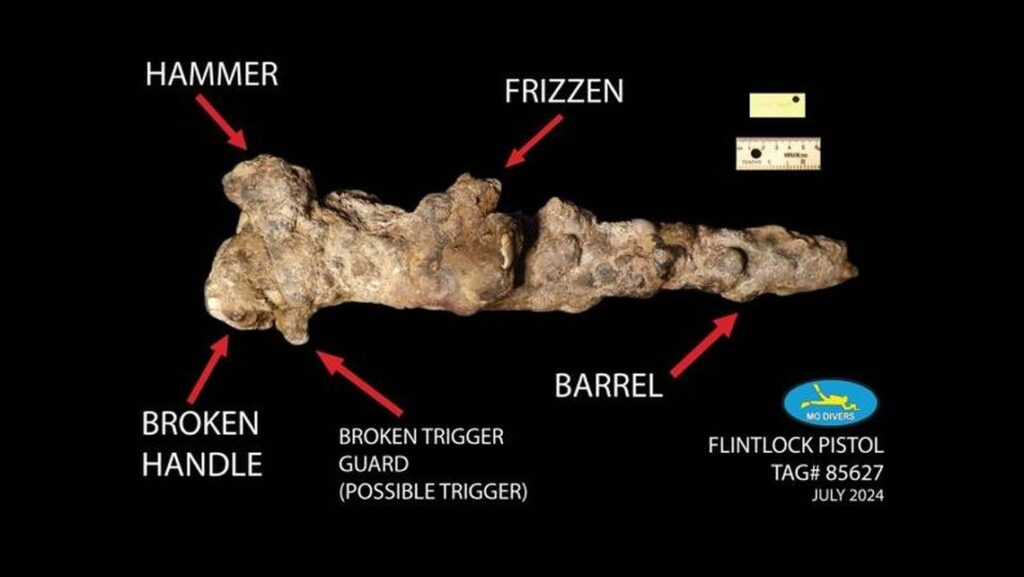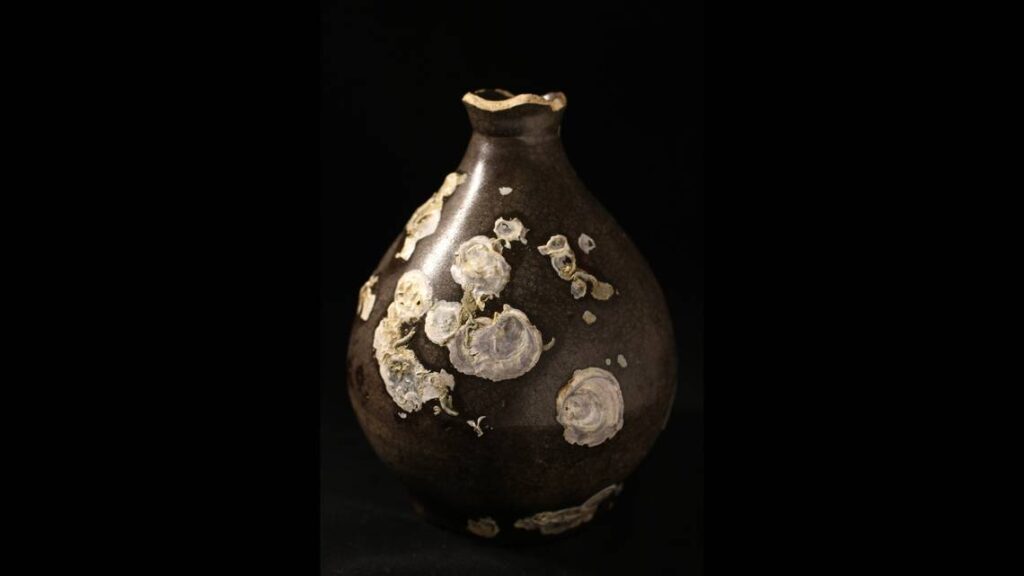MIAMI — Treasures and mysteries are still being found in equal measure on the seafloor off Florida’s Atlantic Coast where a fleet of Spanish ships sank during a 1715 hurricane.
Among the latest finds over the summer: 200 silver coins, a flintlock, an unusual tan vase and a mysterious set of bronze keys, according to a news release from 1715 Fleet – Queens Jewels LLC.
Even more startling, Captain Mike Perna and shipmates Milan Kalelkar and Levin Shavers found “the remains of a wooden box that has been submerged in the ocean for over 300 years.”
The artifacts were recovered along a mile-long “trail of shipwreck scatter” created when as many as a dozen treasure ships spilled their cargo.
Perna said he has been salvaging artifacts off 1715 Fleet for 25 years, and this is the first flintlock he has ever found.
For that reason, he suspects it may end up in the hands of Florida’s Division of Historical Resources, which has a collection devoted to the unusual artifacts pulled off the wrecks.
“If you look at it closely, the hammer is in the cocked position, and that may have happened due to ocean currents after the sinking. It didn’t go down passively,” Perna told McClatchy News.
“The wrecking was very violent, with the ships ripped to pieces in the hurricane. X-rays of the flintlock didn’t tell us a lot. The pistol is heavily encrusted good, a testament to what happens after lying 300 years in the ocean.”
Conservation of the weapon may reveal a name plate, giving historians a fragment of its backstory, he said.

This heavily entrusted flintlock was found over the summer as Capt. Mike Perna and a team of divers explored a shipwreck off Indian River County, Florida (Photo by: Mike Perna)
Flintlock in the sea
“When you think of artifacts like this, the imagination ignites and you ponder the journey these things have been on, and who held them last,” Perna said.
His team was working in about 12 feet of water when they found the weapon concealed in 5 feet of sand. It was surrounded by other artifacts linked to the 1715 Fleet.
It may still be loaded, but it’s difficult to tell, he said.
Removing the hundreds of years of encrustation may reveal a musket ball, but it’s equally likely a great deal of deterioration will be found, he said.
“We may see most of the handle is broken off and trigger guard is gone,” he said. The 200 silver coins, found scattered and in stacks, are what most people want to imagine finding on shipwrecks.
But it’s the unusual things that get the attention of veteran salvage divers.
This summer marked a rare instance of Perna pulling an intact ceramic vase from the sand. Much of the pottery found on the wrecks are in fragments, he said. This delicate vase has a brown glaze, unlike most of the fine china found on the wrecks. Historians suspect it was utilitarian and used for used for spirits.
Even more unusual was the discovery of a wooden box. It didn’t survive intact, but the fragments of wood are a rare find, he said.
Nothing was found inside, which is odd. The fleet went down with countless chests of treasure, including thousands of gold and silver coins, yet very few chests and boxes have been found, Perna said.
Equally mystifying is a set of bronze keys found over the summer.
“Most of the keys are made of iron and they also had silver keys. There is always something mysterious about a key and these are the only bronze keys I’ve ever found,” Perna said.
“Those keys were important to somebody. They may have perished on the wreck. It’s also possible they survived and you have to wonder what happened to them.”

This delicate vase was made in Asia and shipped to Mexico as part of a trade route to Spain. It likely held spirits. (Photo by: Mike Perna)
What happened in 1715?
Years of following the trails of artifacts have revealed a horrific scenario played out during the hurricane, Perna said.
The storm hit on July 31, 1715, as the fleet sailed past what is today Indian River County, Florida.
There are conflicting records on the exact number of ships, but it’s believed at least a dozen were in the convoy “transporting New World cargo, including treasure, to Spain,” 1715 Fleet – Queens Jewels LLC reports.
“Some of the ships were purposely run into the shore, sinking in shallow water, which allowed the surviving Spanish to establish camps and salvage what they could for the royal treasury over the next two years,” the company said.
“Pirates and boats from other countries likely ’fished’ the wrecks in years to follow, but eventually the disaster and record of it faded into history.”
The artifacts being found by Perna and his crew are likely from ships that didn’t survive intact. They broke into pieces, spilling treasure chests and personal belongings as they bobbed up and down in the Atlantic.
The debris first drifted south, then as the eye of the storm passed, began shifting north, Perna said.
Hundreds of thousands of gold and silver coins have been found by salvage crews over the decades.
To date, Perna’s team has found 2,000 silver coins and 13 large gold coins, along with countless other priceless artifacts.
At least five of the ships have yet to be located, indicating more treasure is waiting to be found, Perna said.
“I’ll never finish in my lifetime. We have barely scratched the surface,” he said. “The storm took 10 minutes to deposit what is taking us years to find. Personally, I’m thrilled we’re still allowed to do it.
” Perna’s work is done at the behest of 1715 Fleet – Queens Jewels LLC, which was empowered by the U.S. District Courts to be a custodian and exclusive salvaging company for the fleet.
By MARK PRICE/Charlotte Observer



